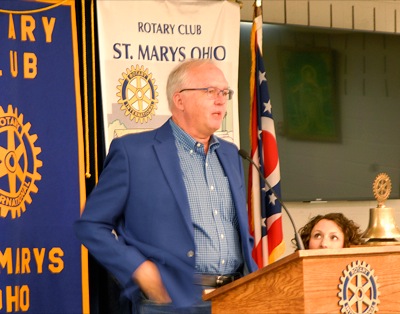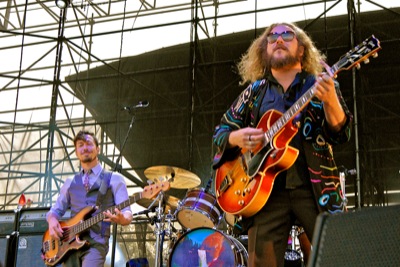Thursday, June 2nd, 2016
Area native playing role in preserving United States' motion picture heritage
By Jared Mauch

Photo by Jared Mauch/The Daily Standard
Randy Haberkamp, managing director of preservation and foundation programs for the Academy of Motion Picture Arts and Sciences, speaks on Wednesday about film restoration to St. Marys Rotary Club members.
ST. MARYS - Movies can bring joy to people but preserving and restoring the actual film can be hard work.
Randy Haberkamp spoke to the St. Marys Rotary Club on Wednesday at the St. Marys Eagles lodge about preserving films, film history and his love for motion pictures.
Haberkamp is the managing director of preservation and foundation programs for the Academy of Motion Picture Arts and Sciences.
"Preservation is going back to the original material or whatever survives. Like everything, film rots. Film deteriorates ... Color fades," he said.
Haberkamp and other archive employees work to clean films of physical and chemical wear and tear to make them look as they did when they were originally released.
Preservers must be careful when handling nitrate film, which was used until the 1950s. It can bubble and explode if the film is not preserved correctly, he said.
Preserving and restoring a film can be a scavenger hunt at times, trying to find good-quality reels of the same film and putting them together.
"Reel one over here might be really good that we have in L.A. The Library of Congress in Washington may have a good reel two, and somebody in Paris may have the good reel three," Haberkamp said.
Other times can be more challenging when segments are missing.
"Right now we're working on a film where it was censored in the 1930s. We have the film, but the soundtrack was cut out," he said.
His department has the complete picture but now must hire actors and actresses to re-create the voices of the missing sections from a newly found script.
The censored material contained sexual innuendo that would seem mild today but was scandalous at the time, he said.
Restoring the film does not mean that the Academy owns it, because many copyrights are still in effect, he said.
Old films can be treated like old cars. Some people see them as trash, while others want to take the time to restore them, Haberkamp said.
The academy has more than 100,000 films in its library.
Any film that is nominated for an Oscar is automatically entered into the academy's film archive, he said after the meeting.
The library has more than 14 million movie photos and posters dating as far back as 1896.
The academy is building a museum that will be finished in 2018, he said.
The academy's collection will be housed there for public viewing. Academy employees are also working on a digital management system for all collections to be searchable and stream movies, photos and sketches to the world, Haberkamp said.
While he acknowledges the glitz and glamor of the Oscars get all the limelight, the advertising dollars generated by the awards show helps fund the preservation efforts Haberkamp does.
Haberkamp, a New Knoxville High School graduate, began making short films as a kid and would frequently see films at the movie theater in St. Marys. He was involved in theater, television production and the school newspaper while at Bowling Green State University.
Haberkamp carried his passion of arts and communication as he completed his graduate work for film school at UCLA before working for CBS and then moving to the Academy of Motion Picture Arts and Sciences.




